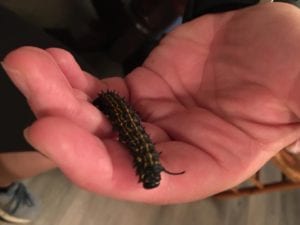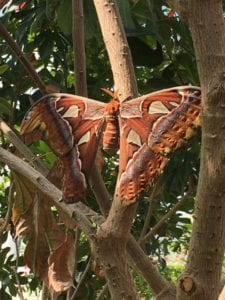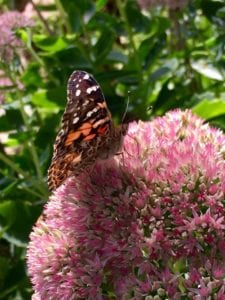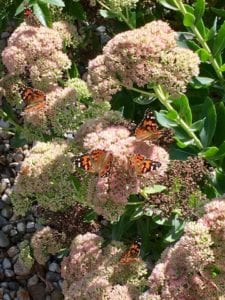

Last Summer, my daughter noticed caterpillars swarming the parking lot of our apartment complex. I helped her catch 3 of the caterpillars, and we put them in a tank we had previously used to raise tadpoles. We added grass, twigs, a small container of water, and leaves. We kept the tank in a well-lit window and checked on the caterpillars regularly. Unfortunately 2 of them died. But the 3rd one…well, we still have him 6 months later.
It turns out that we caught yellow-striped oakworms. Keep in mind, most butterflies and moths stay in their respective chrysalises or cocoons for 5-21 days. But not yellow-striped oakworms (a kind of moth). No, they stay in their cocoons for up to ten months. (Insert facepalm emoji here!) So, before you decide to catch some caterpillars to spend a few weeks teaching your kids about a butterfly life cycle, be sure to research what kind of caterpillar you’re actually getting, or you may end up with a year-long commitment!

Now, on to “Learn About Butterflies Day”.

 First things first: butterflies versus moths. Obviously, my daughter assumed the caterpillars we caught would be butterflies because that’s what young children tend to be taught. Both butterflies and moths start as caterpillars. They both have a pupa stage (the chrysalis or cocoon). And both emerge with large colorful wings covered in tiny scales. They have many differences though. Moths tend to be nocturnal, whereas butterflies prefer the daylight (making them diurnal). When butterflies rest, they typically fold their wings closed, but moths are more likely to rest with their wings spread wide. And while both have antennae, butterfly antennae are thin with a wider tip, and moth antennae are either thin all the way to the end or have lots of “branches” that make them appear feathery.
First things first: butterflies versus moths. Obviously, my daughter assumed the caterpillars we caught would be butterflies because that’s what young children tend to be taught. Both butterflies and moths start as caterpillars. They both have a pupa stage (the chrysalis or cocoon). And both emerge with large colorful wings covered in tiny scales. They have many differences though. Moths tend to be nocturnal, whereas butterflies prefer the daylight (making them diurnal). When butterflies rest, they typically fold their wings closed, but moths are more likely to rest with their wings spread wide. And while both have antennae, butterfly antennae are thin with a wider tip, and moth antennae are either thin all the way to the end or have lots of “branches” that make them appear feathery.
Here are some fun, kid-friendly facts about butterflies for you to share with your family on this wonderful obscure holiday:
- Scientists estimate that there are between 12,000 and 15,000 species of butterflies worldwide. In the United States and Canada, there are approximately 750 species of butterfly.
- The largest butterfly is the Queen Alexandra Birdwing, with a wingspan of nearly a foot (12 inches). They live in Papua New Guinea.
- The smallest butterfly is the Western Pygmy Blue. Their wings only span about half an inch and they live in the Western United States.
- Some of the most common butterflies in the United States are the Monarch and the Swallowtails.
- Painted Lady butterflies of southern Europe make an annual migration of approximately 7,500 miles into Africa.
- While caterpillars eat plant material, butterflies mostly live on a liquid diet (nectar from flowers).
- Butterflies can not fly if they are cold.
- A group of butterflies is called a flutter.
- Butterflies taste with their feet.
- Most butterflies lay between 100 and 300 eggs at a time, but monarchs are known to lay as many as 500!
There are several things you can do if you want to make your yard more attractive to butterflies:
- Plant colorful flowers with flat tops or short flowering tubes. Butterflies are attracted to reds, yellows, purples, pinks, and oranges. Some suggestions are phlox, marigolds, black-eyed Susans, lavender, and sunflowers.
- Stop using pesticides in your yard. These are harmful to butterflies.
- Create a butterfly spa. Think a birdbath, but for butterflies. Fill a shallow dish with water, add sand or rocks, and place it in a sunny spot.
Finally, here is a really neat video showing how a caterpillar transforms into a butterfly:
















